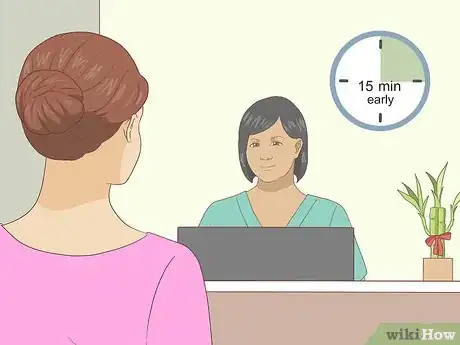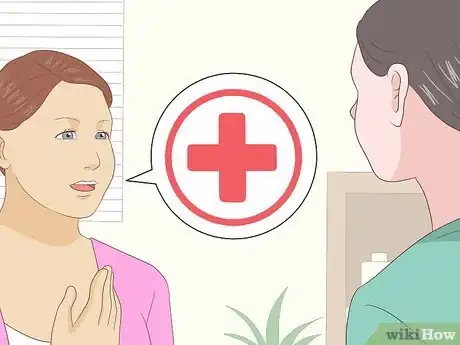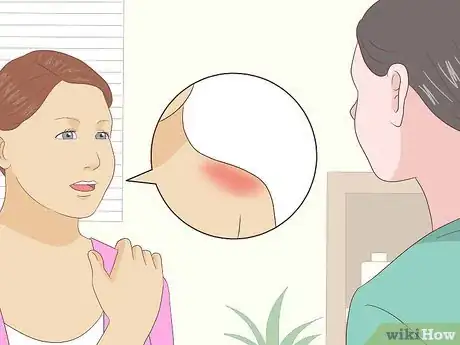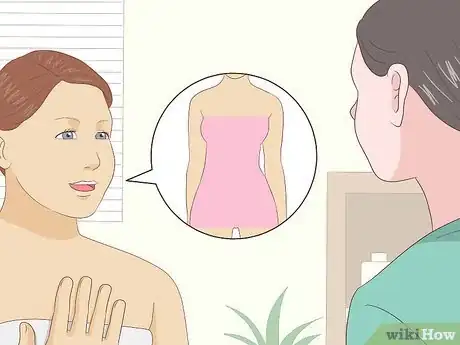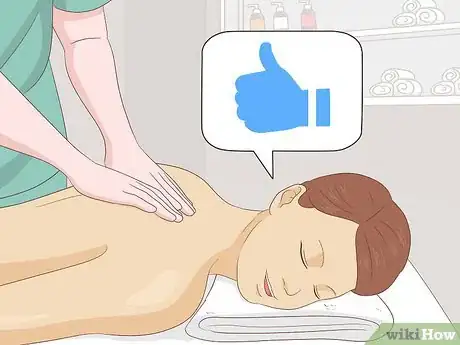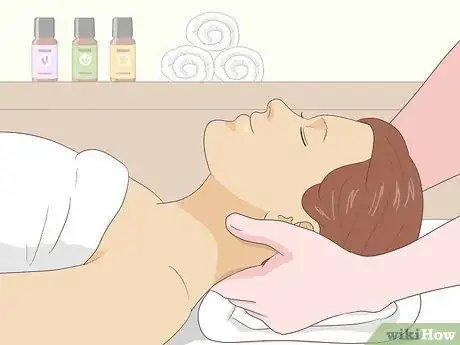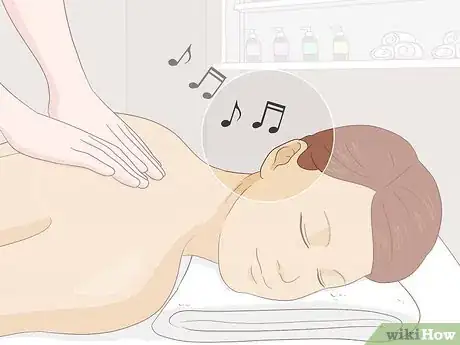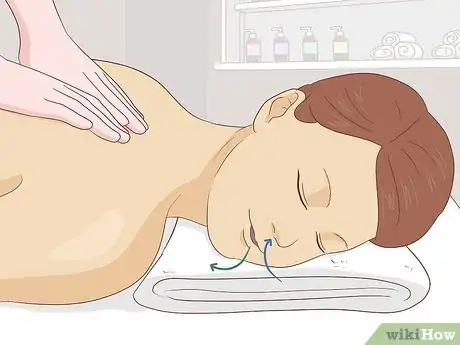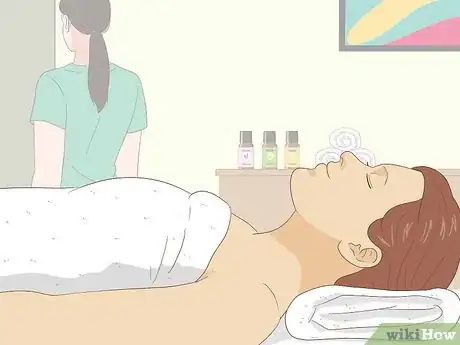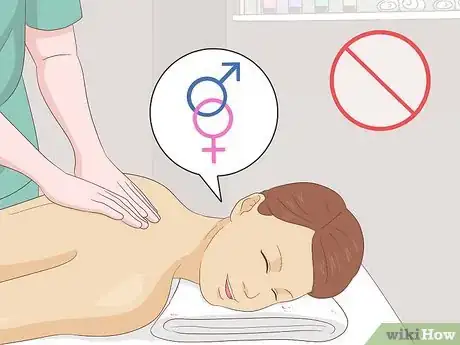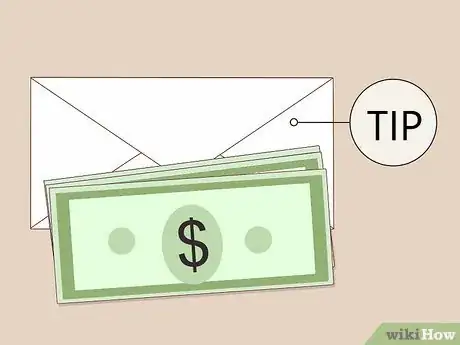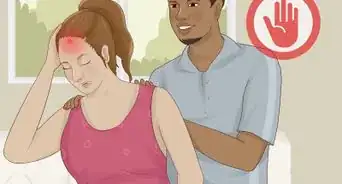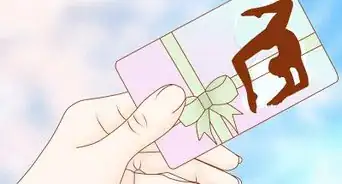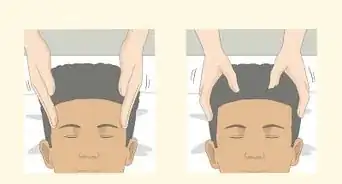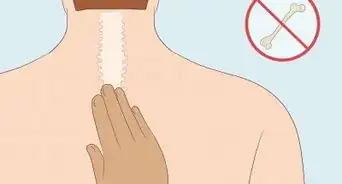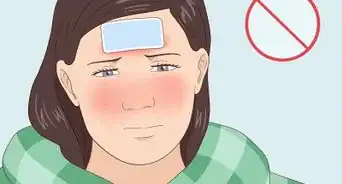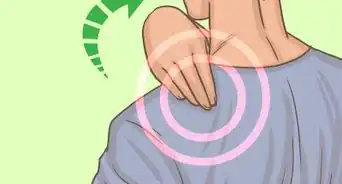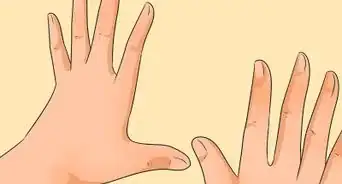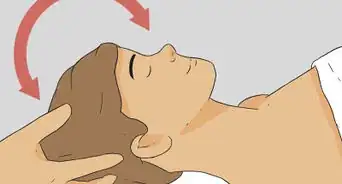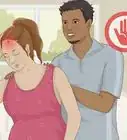This article was co-authored by Will Fuller and by wikiHow staff writer, Megaera Lorenz, PhD. Will Fuller is a Certified Massage Therapist and Wellness Educator working in San Francisco, California. Will has worked with the Sports and Recreation Center at the University of California, San Francisco (UCSF), taught sports in England, Kenya, and Kuwait, and is now affiliated with the Chiro-Medical Group. He was trained in physical rehabilitation under a program founded by Dr. Meir Schneider. He has a Bachelors in Sport Science and a Post-Graduate Certificate of Education in Physical Education from Southampton University.
There are 7 references cited in this article, which can be found at the bottom of the page.
This article has been viewed 165,436 times.
A massage can be wonderfully relaxing and therapeutic. But if you’ve never had one before, it’s natural to be a little nervous and uncertain about what to expect. To get the most out of your massage, take time to communicate openly and honestly with your massage therapist. They can answer any questions you have and work with you to make your experience as helpful and enjoyable as possible.
Steps
Communicating with Your Therapist
-
1Arrive early so you can fill out any required forms. If it’s your first time getting a professional massage, you’ll probably need to fill out some paperwork first. Try to get to your appointment at least 15 minutes early to avoid cutting into your massage session.[1]
- Arriving early will also help you get into a more relaxed frame of mind. It will be much easier to unwind if you can get all that paperwork out of the way as soon as possible![2]
-
2Talk to your therapist about any health concerns you have. For most people, massage is very safe if it’s done by a professional therapist. However, there are some health conditions that might make it risky for you to get a massage, like bleeding disorders or recent injuries. Let your massage therapist know about your health history and whether there are any issues they should know about.[3]
- If you’re not sure whether a massage is safe for you, get your doctor’s advice first.
- Let your therapist know if you have any allergies, since this might affect what kinds of oils or lotions they can use.
- If you’re having symptoms like dizziness, nausea, fever, or skin rashes, cancel your appointment and reschedule it when you’re feeling better or your doctor says it’s okay.[4]
Advertisement -
3Let your therapist know if there are any areas you want them to focus on. Before the massage, your therapist will talk to you about what you want from the session. Let them know if there are any parts of your body where you feel especially stiff, tense, or achy. They can use that information to plan a more relaxing and enjoyable massage for you.[5]
- For example, you might mention if you have a lot of tension in your upper back and shoulders, or if you experience symptoms like numbness in your hands or fingers.
- If you’re getting massage as therapy for a medical condition, such as migraines or a repetitive stress injury, make sure to let your therapist know.[6]
-
4Explain any special requests you have to make your session more enjoyable. Some people like listening to music or chatting with the therapist during a massage, while others prefer silence. You might also have preferences about things like massage technique, room temperature, lighting, and scents. Tell your therapist ahead of time if you have any strong preferences about these parts of your experience.[7]
- For instance, you could say, “Would you be able to use unscented massage oils? Strong perfume smells bother me.” Or, “My feet are really sensitive, so can you just use very light pressure when you work on them?”
- If you’ve never had a massage before, you might not know yet what you prefer. It’s okay to speak up if you change your mind about something during the massage.
-
5Ask any questions you might have about the massage process. If you have any concerns or questions about what your massage session will be like, don’t hesitate to bring them up. A good therapist will be happy to answer your questions, put your mind at ease, and talk you through any part of the process you might not understand.[8]
- For example, you might ask things like, “What kinds of oils or lotions will you be using today?” or “What will the massage feel like? Should I expect any of it to hurt or feel uncomfortable?”
-
6Tell your therapist if there are any parts of your body you don’t want exposed. Before your massage starts, your therapist will probably ask you to undress. They should step out of the room so you can undress in private and cover yourself up with a sheet or blanket. Let them know if there are any parts of your body that you’d like them to avoid touching or leave covered during the massage.[9]
- You can undress completely or just take off some of your clothing, like your shirt or pants. Do whatever you feel most comfortable with.
Be aware: During the massage, your body should be draped with a blanket or sheet the entire time. Your therapist should only uncover the part of your body that they’re working on at any given moment. It’s never appropriate for a professional therapist to expose your genitals, breasts, or any other part of your body that you’ve asked them to leave covered.[10]
-
7Give your therapist feedback about their technique during the massage. While the massage is happening, don’t be afraid to speak up about anything the therapist is doing, good or bad. Tell them if you’re uncomfortable with anything they’re doing, and keep in mind that you have the right to end the massage at any time.[11]
- For example, you might say things like, “I’m a little cold, would you mind giving me a warmer blanket?” or “It’s okay if you apply a little more pressure there.”
Enjoying Your Massage
-
1Stay as relaxed as possible to help the massage work better. A good massage is meant to relax your body and mind. You can help this process along by doing your best to release as much tension as possible. Avoid tensing up your muscles, which will make the massage less comfortable and relaxing.[12]
- Try practicing relaxation techniques before your massage session, such as meditation, deep breathing exercises, or progressive muscle relaxation. You can use those same techniques during the massage to help you unwind.
-
2Focus on your senses to help you unwind. If you’re having trouble relaxing, try to focus your thoughts on what you’re feeling. Concentrate on how your therapist’s hands feel on your aching muscles, the scent of the massage oil, or the sound of the peaceful music or your therapist’s voice, if they’re speaking.[13]
- If you find your thoughts wandering, just gently redirect them back to the present moment.
-
3Keep breathing to help your muscles relax. You might instinctively hold your breath during uncomfortable moments, like when your therapist is working on a particularly tough knot in your muscles. If this happens, try to breathe normally. This will help both your mind and your body relax.[14]
- Try breathing slowly in through your nose, holding the breath for a few seconds, and then slowly breathing out through your mouth. Your belly should rise and fall as you breathe rather than your chest or shoulders.
Tip: If you’re still feeling tense even with all your efforts to relax, let your massage therapist know. They might be able to help by adjusting their technique or making changes to the environment to help you get more comfortable.[15]
-
4Take a few moments to rest after the massage is over. Once the massage is done, your therapist will step out to allow you to get dressed. Don’t immediately jump off the table once they leave. Instead, take a few minutes to just breathe and relax, then sit up slowly. Be careful when you stand, since you might feel dizzy or faint if you get up too quickly.[16]
- If possible, take some time to relax after you leave the spa or clinic, too. The relaxing and therapeutic effects of the massage will last longer if you don’t jump right back into your regular activities.
Following Massage Etiquette
-
1Take a shower before you arrive at your session. For your own sake and your therapist’s, arrive at your session fresh and clean. Not only will you smell nicer, but your therapist won’t be rubbing irritating dirt, germs, body oils, and sweat into your skin![17]
- Your therapist will probably work on your feet if you’re getting a full-body massage, so make sure your nails are trimmed and clean.
-
2Silence your phone before the session starts. A massage is supposed to be a peaceful, relaxing experience. Prevent unwanted distractions by turning off your phone, setting it to silent, or putting it in “Do Not Disturb” mode before your session starts.[18]
- If you have a smartwatch, don’t forget to silence that, too!
-
3Avoid making any inappropriate jokes or requests. Treat your therapist with the same kind of courtesy and respect that you’d expect from them. Don’t make any sexual or inappropriate jokes, comments, or requests. A massage is an intimate experience, but it’s also important to keep things professional and respect appropriate boundaries.[19]
- You may even have to sign a statement that you will not make any inappropriate comments during the massage. If you cross the line, your therapist has the right to end the massage and ask you to leave!
-
4Leave a tip for your therapist to show your appreciation. In addition to the basic fee for the massage, it’s a good idea to add in a little extra for your therapist. You might have a chance to leave your tip in an envelope at the front desk when you arrive or leave, or you could hand it to your therapist directly if you prefer.[20]
- In general, 15-20% is a good amount for a tip, but it may depend on the specific spa or clinic you visit.
- If you’re using a gift certificate or if someone else paid for the massage, ask if the tip was included when you check in.
Expert Q&A
Did you know you can get premium answers for this article?
Unlock premium answers by supporting wikiHow
-
QuestionWhat causes numbness and tingling in your fingertips?
 Will FullerWill Fuller is a Certified Massage Therapist and Wellness Educator working in San Francisco, California. Will has worked with the Sports and Recreation Center at the University of California, San Francisco (UCSF), taught sports in England, Kenya, and Kuwait, and is now affiliated with the Chiro-Medical Group. He was trained in physical rehabilitation under a program founded by Dr. Meir Schneider. He has a Bachelors in Sport Science and a Post-Graduate Certificate of Education in Physical Education from Southampton University.
Will FullerWill Fuller is a Certified Massage Therapist and Wellness Educator working in San Francisco, California. Will has worked with the Sports and Recreation Center at the University of California, San Francisco (UCSF), taught sports in England, Kenya, and Kuwait, and is now affiliated with the Chiro-Medical Group. He was trained in physical rehabilitation under a program founded by Dr. Meir Schneider. He has a Bachelors in Sport Science and a Post-Graduate Certificate of Education in Physical Education from Southampton University.
Certified Massage Therapist Tingling or numbness in your fingers could indicate a number of different issues. For instance, your wrists may be tight, so you may need your massage therapist to work your wrists, rather than your hands. It could also be thoracic outlet syndrome, so your therapist would need to be working your chest. However, it might also be compression in your cervical spine, in which case you might need to see a chiropractor to release the compression on the nerve in your neck.
Tingling or numbness in your fingers could indicate a number of different issues. For instance, your wrists may be tight, so you may need your massage therapist to work your wrists, rather than your hands. It could also be thoracic outlet syndrome, so your therapist would need to be working your chest. However, it might also be compression in your cervical spine, in which case you might need to see a chiropractor to release the compression on the nerve in your neck. -
QuestionWhat if someone isn’t very comfortable with being touched in certain areas (meaning wrists and neck)?
 wikiHow Staff EditorThis answer was written by one of our trained team of researchers who validated it for accuracy and comprehensiveness.
wikiHow Staff EditorThis answer was written by one of our trained team of researchers who validated it for accuracy and comprehensiveness.
Staff Answer wikiHow Staff EditorStaff Answer
wikiHow Staff EditorStaff Answer -
QuestionIs it appropriate to ask the massage therapist to massage sensitive areas or private parts?
 wikiHow Staff EditorThis answer was written by one of our trained team of researchers who validated it for accuracy and comprehensiveness.
wikiHow Staff EditorThis answer was written by one of our trained team of researchers who validated it for accuracy and comprehensiveness.
Staff Answer wikiHow Staff EditorStaff AnswerIt depends. For example, in the U.S., it's legal in some states for massage therapists to massage a client's breasts (with the client's permission, of course!). However, the genitals and the area between the buttocks are almost always off limits. If you ask your therapist to massage a sensitive area, such as your breasts or butt, make sure to phrase your request in a respectful and professional way.
wikiHow Staff EditorStaff AnswerIt depends. For example, in the U.S., it's legal in some states for massage therapists to massage a client's breasts (with the client's permission, of course!). However, the genitals and the area between the buttocks are almost always off limits. If you ask your therapist to massage a sensitive area, such as your breasts or butt, make sure to phrase your request in a respectful and professional way.
Warnings
- Talk to your doctor before getting a massage if you’re prone to blood clots, take blood-thinning medication, or have a severely low platelet count. You should also get your doctor’s advice if you have broken or fragile bones, any recent injuries (such as from a car accident), or skin damage such as burns, bruises, or rashes.[24]⧼thumbs_response⧽
References
- ↑ https://www.takingcharge.csh.umn.edu/explore-healing-practices/massage-therapy/what-can-i-expect-first-massage-theraphy-visit
- ↑ https://www.starkstate.edu/massage-therapy-clinic/10-tips-get-most-your-massage/
- ↑ https://www.mayoclinic.org/healthy-lifestyle/stress-management/in-depth/massage/art-20045743
- ↑ https://www.takingcharge.csh.umn.edu/explore-healing-practices/massage-therapy/what-can-i-expect-first-massage-theraphy-visit
- ↑ https://www.takingcharge.csh.umn.edu/explore-healing-practices/massage-therapy/what-can-i-expect-first-massage-theraphy-visit
- ↑ https://www.ucsfhealth.org/treatments/massage
- ↑ https://www.starkstate.edu/massage-therapy-clinic/10-tips-get-most-your-massage/
- ↑ https://www.starkstate.edu/massage-therapy-clinic/10-tips-get-most-your-massage/
- ↑ https://www.takingcharge.csh.umn.edu/explore-healing-practices/massage-therapy/what-can-i-expect-first-massage-theraphy-visit
- ↑ https://www.takingcharge.csh.umn.edu/explore-healing-practices/massage-therapy/what-can-i-expect-first-massage-theraphy-visit
- ↑ https://www.starkstate.edu/massage-therapy-clinic/10-tips-get-most-your-massage/
- ↑ https://www.starkstate.edu/massage-therapy-clinic/10-tips-get-most-your-massage/
- ↑ https://www.takingcharge.csh.umn.edu/explore-healing-practices/massage-therapy/what-can-i-expect-first-massage-theraphy-visit
- ↑ https://www.starkstate.edu/massage-therapy-clinic/10-tips-get-most-your-massage/
- ↑ https://www.takingcharge.csh.umn.edu/explore-healing-practices/massage-therapy/what-can-i-expect-first-massage-theraphy-visit
- ↑ https://www.takingcharge.csh.umn.edu/explore-healing-practices/massage-therapy/what-can-i-expect-first-massage-theraphy-visit
- ↑ https://clarysagecollege.com/news/massage-etiquette-101-from-stripping-to-tipping/
- ↑ https://www.artofmanliness.com/articles/massage-etiquette-for-men-8-things-to-keep-in-mind/
- ↑ https://www.amtamassage.org/find-massage-therapist/what-to-expect-at-massage-session/
- ↑ https://clarysagecollege.com/news/massage-etiquette-101-from-stripping-to-tipping/
- ↑ https://www.takingcharge.csh.umn.edu/explore-healing-practices/massage-therapy/what-can-i-expect-first-massage-theraphy-visit
- ↑ https://www.takingcharge.csh.umn.edu/explore-healing-practices/massage-therapy/what-can-i-expect-first-massage-theraphy-visit
- ↑ https://www.takingcharge.csh.umn.edu/explore-healing-practices/massage-therapy/what-can-i-expect-first-massage-theraphy-visit
- ↑ https://www.mayoclinic.org/healthy-lifestyle/stress-management/in-depth/massage/art-20045743
